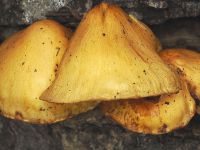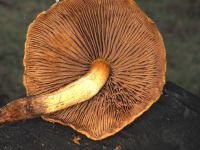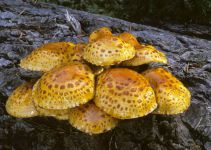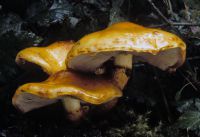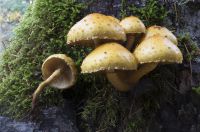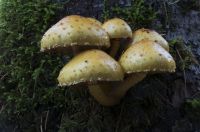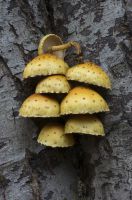Distribution: Broad
Habitat: Northern temperate and boreal forests
Conservation Status: Not of concern
Edibility: P. aurivella has been listed as edible, but David Arora reported in Mushrooms Demystified that several people had experienced gastric upsets and that the taste of the mushrooms resembled “marshmallows without the sugar.”
P. aurivella has been listed as edible, but David Arora reported in Mushrooms Demystified that several people had experienced gastric upsets and that the taste of the mushrooms resembled “marshmallows without the sugar.”
Pholiota aurivella is perhaps the most noticeable of the pholiotas. It is large, bright yellow to golden yellow-orange when young, and grows in large clusters on live trees, snags, and logs of conifers and hardwoods. The cap is viscid when young, and bears dark brown or reddish brown scales that contrast with the yellow cap color. The stipe is whitish, or somewhat yellowish, and scaly below the ring-zone. P. adiposa is another name for the same fungus and some mycologists feel it is preferable. To further confuse matters, P. limonella is virtually identical in appearance, but has somewhat smaller spores and is incompatible in laboratory mating studies. Many other species have been named in North America but several, such as P. abietis, P. connata, and P. subvelutipes, have been shown to be variants of P. limonella and it remains to be seen whether the others merit species status or are variants of P. aurivella or P. limonella. Mating studies and close attention to ecological occurrence would help clarify the matter. Given the difficulties in assigning species names, it is difficult to know the distributions of these species.
PNW Herbaria: Specimen records of Pholiota aurivella in the Consortium of Pacific Northwest Herbaria database
CalPhotos: Pholiota aurivella photos


